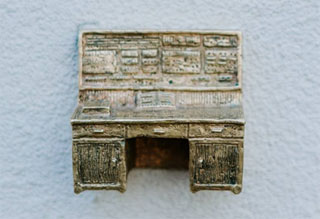|
Kiev Computer Mini Sculpture opened on 20.03.2019 in Kiev |
The installation of the sculpture is a part of tourist project "Search" created by travel guide Yulia Bevzenko. Author of Kiev Computer Mini Sculpture is sculptor Daria Vovk. This moment there are other main symbols of Kiev that are presented in mini-sculptures around Kiev city center - Chicken Kiev, Kiev Chestnut, Kiev Cake, Kiev Tram, Kiev First Car Benz Velo, Kiev Brick Plinfa, Kiev Elephant, Kiev Gramophone, Kiev Golden Pectoral, Fountain of Samson. History of Kiev Computer - Small Electronic Computing Machine created by Sergey Lebedev Sergey Lebedev began to work in branch of high-speed electronic counting machines at the end of 1948. In 1948 - 1949 he developed the basic principles for constructing of such machines consisting of basic devices: arithmetic, memory, control, input-output and some external ones for preparing and decoding information with punched tapes and cards. Small Electronic Computing Machine (SECM) was conceived by Sergey Lebedev as a model of Large Electronic Computing Machine (LECM). Initially it was called Model Electronic Computing Machine. In the process of its creation information input and output devices, memory on a magnetic drum were added and capacity was increased - the word "Model" was replaced by the word "Small". The principle of operation of Small Electronic Computing Machine is the principle of an adding machine (arithmometer). The basic requirements for such a machine is acceleration and automation of processes. The speed of operations is assumed to be 100 operations per second. The number of characters is limited to five in decimal system (16 characters of the binary system). The storage device had to be created on trigger cells which limited capacity of the machine. The main element of Small Electronic Computing Machine is an element that allows summation. Trigger cells were used and the current is transferred from one lamp to another by applying pulses to the grid. This makes it possible to produce the summation operations from which all other operations are formed. Instead of the decimal system binary is used which is determined by the properties of trigger cells. In addition to the elements for the summation the machine has elements that control the calculation process. Such elements are permissive devices and memorization elements. The machine could make summation, subtraction, multiplication, division and a number of such actions as comparison, shift, stop, possibility of adding operations is provided. 12 scientists participated in the development and creation of Small Electronic Computing Machine together with Sergey Lebedev who were assisted by 15 technicians and installers. For comparison in addition to 13 main scientists 200 technicians and a large number of workers participated in creation of the first American Computer ENIAC ("Giant Brain" designed by John Mauchly and J. Presper Eckert in 1946, cost almost 487 000 USD (approximately 7 051 000 USD today). In 1950 when the model of Small Electronic Computing Machine was tested a similar machine worked in Europe only in England - early British computer EDSAC constructed by Maurice Wilkes in 1949. The arithmetic device of sequential action was used in EDSAC and the parallel and more progressive in SECM. In 1951 the laboratory of Sergey Lebedev was tasked to transfer the model to a working machine. By the autumn of 1951 the complex test program was fairly stable and it was possible to proceed to the solution of test real-world problems. Small Electronic Computing Machine First Tests The first test problem was chosen from the field of ballistics with very substantial simplifications - air resistance was not taken into account. The control calculation was performed by by mathematicians directly in the binary system which made it possible to check the machine by cycles and cycles observing by the control panel signaling the correctness of program execution. At this time the remarkable episode occurred - the electronic computer first discovered and localized the error of the control calculation of two highly skilled mathematicians. Such mathematicians performed the calculations of the test example independently and both were mistaken in the same way. The essence of the calculations was as follows: the law of motion of an object having a certain mass and initial velocity and launched at a certain angle to the surface is the equation of a parabola. Solving this equation it is possible to determine the current coordinates of the object being launched during the entire flight time as well as the distance from the launch point to the point of incidence. The possibility of an exact analytical numerical solution of this problem allows to check the operation of the machine and estimate the resulting accuracy. The trajectory was divided into 32 segments on each coordinates of the object were calculated. At first everything went well. The results of the machine calculation in all 20 binary digits completely coincided with those that were obtained manually but in the eighth segment an absolutely insignificant discrepancy was revealed which should not have been. Repeated calculations did not change anything. The machine gave the same result which differed from the manual calculations for one unit of the lower order. So Sergey Lebedev who never believed in "miracles" said: "I myself will check the manual calculations to the 9th point". And checked it even it was a very time-consuming work when calculating in the binary system. He left the group of scientists to check the calculations in another room and performed the necessary calculations in a regular notebook. Calculations continued all day and on the other Sergey Lebedev appeared smiling which very rarely happened, his glasses were pushed onto his forehead which indicated good luck and said: "Do not torture the machine - it is right. People are not right!". It turns out that he found a mistake in the duplicated manual counting. Everyone was literally shocked and froze in amazement and mathematicians rushed to recalculate the remaining 24 points since the calculations were recurrent and it was pointless to continue further checking if there was an error in the manual calculations. But the calculations had to be postponed to the next day - this event happened at 2am night and although many enthusiasts did not want to wait Sergey Lebedev did not allow: “We must give the machine a few hours rest. Let's go and we will have rest. Tomorrow everything will be all right!”. And so it was - in the morning new calculations were brought and the machine duplicated them without any discrepancies. It was the first real problem solved by Small Electronic Computing Machine. The fundamentals of computer construction developed by Sergey Lebedev without changes are also used in modern computer technology: 1) computer should include devices of arithmetic, memory, input-output information, control SECM was operated until 1957 and next transferred to Kiev Polytechnic Institute for training purposes. Just in two years In 1959 Small Electronic Computing Machine was dismantled, cut into pieces, number of teaching stands were organized and then all the machine was thrown away. Some of the remaining electron tubes from SECM and other components are stored in Foundation for History and Development of Computer Science and Technology at Kiev House of Scientists of National Academy of Sciences of Ukraine. The building of the laboratory where located Small Electronic Computing Machine is still exist in Kiev by address Akademika Lebedjeva St, 19 and belongs to St. Panteleimon Women's Monastery. Interesting Facts About Small Electronic Computing Machine When developing Small Electronic Computing Machine was made only one critical mistake - for SECM was allocated space on the lower floor of a two-story building which housed the laboratory. When it was mounted and turned on under voltage six thousand heated electronic tubes turned the room into the tropics. It had to remove part of the ceiling to remove at least some heat from the room with Small Electronic Computing Machine. Organizers of Kiev Computer Mini Sculpture
Team of Project "Search" |
Information about Kiev Hotels, Hostels, Restaurants, Supermarkets on Kiev Map
|
|

Book your tour or request information: |
|
- please, look at reviews of tourists about our tours
|
© 2011 - 2026 All rights reserved |


